BRUCE DARNELL reporter
SIUE has seen an influx of gradu ate students entering the university, many of which have been dealing with multiple economic issues as a result of high inflation and low salaries.
Charles Hubbs, a grad student in his second year, is facing some of these eco nomic problems.
“Covering [tuition] is great, but I can’t eat tuition coverage,” Hubbs said. “That doesn’t put food in my stomach.”



Hubbs works as a teaching assistant at SIUE and as a physical trainer on and off campus. The TA job pays for tuition as well as a stipend. His stipend, which totals approximately to $400 a month, is usually spent on student fees.
“This is my first time working for SIUE,” Hubbs said. “During my first grad uate program, I worked full-time at the St. Louis Art Museum, where wages were also low. When I did my undergrad program here, I worked multiple part-time jobs — kind of like what I’m doing now — to try and afford some basic things.”
McKenzie Johnston, an English litera ture graduate student at SIUE, is also fac ing similar issues.
“I only get paid about $860 a month, which is take-home pay,” Johnston said. “The tuition waiver covers everything ex cept fees, but the fees are $1,000 per semes ter… Right now, I’m teaching one class. Typically, the load is two classes.”
Johnston is a teaching assistant at SIUE and is also employed as an adjunct professor at a community college in Mis souri. She previously worked as a teaching assistant at SIU Carbondale, where the sal ary is double what it is at SIUE.
“$860 minus $250 per month [due to fees] means I’m getting paid about $600 a month,” Johnston said. “For perspective, at a rural community college in Missouri I get paid about $1,000 take-home pay for teach ing two classes; the classes are also smaller. Here I’m teaching 23 students, taking class es of my own and having to pay my fees.”
Johnston said the fees that she must pay would be acceptable if the grad students could adequately use some of the services they pay for, but they often don’t have time in their schedule. One such service would
be the gym.
“Going to the gym? I would challenge you to find more than a handful [of grad stu dents] that have the time to go to the gym,” Johnston said. “Graduate students are often professionals. Most of their time is spent doing research and not using the gym.”
The fees are also used to rent out textbooks, though Johnston states that many students in the English depart ment would much rather purchase textbooks.
“We want to own our text books and would happily use the rent fees to buy the textbooks in stead of renting them. We want to keep those books and use them in the future, but there isn’t an op tion for that,” Johnston said.

There are also fears that getting a de gree may not provide financial security af ter graduation, which makes grad students’ financial situation even more unstable. Hubbs has experienced these fears himself.

“I’ve been there and done that,” Hubbs said. “[A degree] doesn’t always get a job that pays well… I’ve moved fields, maybe that will make a difference, but I’m still skeptical. Really anything that isn’t STEM is a coin toss.”
The location of SIUE’s campus creates difficulty as well, which Johnston attributes to many grad students living off-campus.
“For graduate students, Edwardsville is in the middle of nowhere,” Johnston said. “Not very many graduate students, in comparison to undergrads, are going to live on-campus. We have families and other jobs… having to drive out there adds on [to expenses] to what little money we do make.”
Johnston’s personal hardship is also
made more difficult by her 5-month-old baby that she must care for, which has in creased her spending on formula and rent for a bigger apartment.
“Finances are so intricately tied togeth er that it’s hard to say that it’s because of SIUE,” Johnston said. “However, I could say that if I were paid at SIUE what I make at any other community col lege as an adjunct and didn’t have to pay fees, then I wouldn’t be hav ing the difficulty that I’m having.”
All of these expenses make it hard to save up cash. Hubbs said that it would be nice to have the opportunity to save up mon ey for life after college rather than spending much of it on fees.
“There’s defi nitely a transition period from ending school to entering the workforce,” Hubbs said. “Bills never stop and you never stop getting hungry. There’s no guarantees once you get out there.”
These difficulties are being met amidst a record growth in grad students enrolled at SIUE. James Monahan, director of gradu ate and international admissions at SIUE, gave further details on how many new grad students there are.

“This is about our fourth straight year of increase in graduate enrollment,” Mona han said. “It has brought the total number of graduate students at the university to its highest level since 1977. It’s been some strong growth.”
The reason for this growth has not been by chance, Monahan stated, rather caused by a series of developments that have made the school more attractive for pro spective students.
“The academic departments have really been focusing on meeting student’s needs
and providing them with flexible schedules, online courses and the ability to complete the graduate program on your time; we’ve done a better job on that,” Monahan said. “A lot of our graduate students are work ing, so they need classes that meet in the evenings or on the weekends.”
Monahan also said that graduate pro grams have grown across the country due to the pandemic, mainly because people had the time to decide on pursuing a higher-lev el degree. He also acknowledged the harsh economic difficulties faced by some gradu ate students.
“We know it’s a struggle,” Monahan said. “There are quite a few graduate assis tantships [at SIUE], but they’re competitive and not all can get it. I certainly recognize the challenges you face in getting a gradu ate degree, but you hope that once you’ve completed it and get out, you’re going to see that higher salary and job security. I acknowledge that it’s difficult sometimes.”
Monahan also described that SIUE has experienced significant growth in interna tional students, with a large percentage of them being grad students.
“We’ve seen an explosive growth in international students, particularly in the STEM fields,” Monahan said. “We’ve seen big growth in computer science, business and engineering... About twothirds of our international students are graduate students.”
SIUE had a 177 percent increase in international students compared to last year. There are approximately 891 new in ternational students at SIUE this semes ter. Of those, 652 are grad students, and a considerable portion of these students work on-campus.
“International students can only work on-campus,” Monahan said. “That’s a part of immigration regulations. If those stu dents are employed, they’re only going to be employed at the university.”
The growth at SIUE has contributed to its growing reputation as a university and may continue into the near future given re cent trends.
“It’s nice to see the numbers grow,” Monahan said. “I think it helps the universi ty’s reputation overall when you have strong graduate programs and a lot of research that provides opportunities for our undergrad and graduate students.”
‘Be a force for good’: Pharmacist awarded for excellence in Edwardsville
NICOLE BOYD opinion editor
Tapiwa Mupereki, a local pharmacist, was recognized with the monthly Excel lence in Edwardsville award. He was given the award for starting the Books for Bikes summer reading challenge, which encour aged children to read with the chance to win one of 14 bikes.


Mupereki, co-founder and CEO of JewelRide, a company that provides trans portation to medical appointments, said it’s very humbling to be recognized. He said that as a company, they never know the extent of their impact, so they strive to be a force for good in society.
“When you just focus on being a force for good, you don’t realize that people are taking notice of that,” Mupereki said.
“When we did this … summer reading challenge, there was no intention that it was going to be noticed … if you are a force for good, you never know what other positive impacts it could create.”
Mupereki said his drive for public service partly comes from his upbringing in a rural village in Zimbabwe, and when he later moved to a mining town. He said people are trying to help each other to solve problems in those communities.
“I saw many people trying to come to my help in various ways, whether that was when I was in school or adjusting in the community,” Mupereki said. “Our mission is to empower individuals to access quality care, but that is not enough. As a business, there’s also an expectation for us to be a force for good in the communities that we serve.”
James Arnold, the economic and com munity developer and grants coordinator for the city of Edwardsville, said he and Li brary Director Jill Schardt nominated Mu pereki not only because of his idea for the reading challenge, but because he took it upon himself to donate $3,500 to purchase 10 bikes – an act that spurred oth er local businesses to donate bikes as well.
“Excellence in Edwardsville [is] just to highlight special people doing special things in our own community, and I firmly believe that an action like that fits the bill,” Arnold said.
Arnold said Mupereki is incredibly energetic and full of ideas.
“When you work for a city
and you have a gentleman, a business member that lives and works and breathes in your community and comes to you with new ideas, it’s great,” Arnold said. “It helps make Edwardsville special.”
Safe
PAGE 4 follow the alestle @alestlelive See you on the Internet!@TheAlestle @Online Editor Alestle @thealestle the
THE
Zone fundraises through drag bingo
student voice since 1960 alestle
Vol.
No. 10
PAGE 3
ends a
PAGE 8
Southern
Illinois University Edwardsville Thursday, November 10, 2022
76
Music faculty member recounts musical journey to Carnegie Hall
Men’s soccer
long season
“
I could say that if I were paid at SIUE what I make at any other community college as an adjunct and didn’t have to pay fees, then I wouldn’t be having the difficulty that I’m having. ”
McKenzie Johnston, English literature graduate student
11.01.22
Two wallets were found in the MUC.
11.03.22
A Student ID was found in Building # 271 on the Alton Campus.

A hit and run was reported on University Drive near Supporting Services Road.
A cordless drill, which was property of SIUE, was stolen from the East St. Louis Campus.
11.04.22
A traffic accident was reported in the Woodland Hall Parking Lot.
Three hours after the previous acci dent, a vehicle was reportedly doing burnouts in the Woodland Hall Parking Lot.
A debit card was found in the MUC.
NEWS IN BRIEF
Student Government VP position open after Burbach steps down
Nicole Burbach has stepped down from Student Government Vice President due to personal rea sons, leaving the Vice Presidential position open.
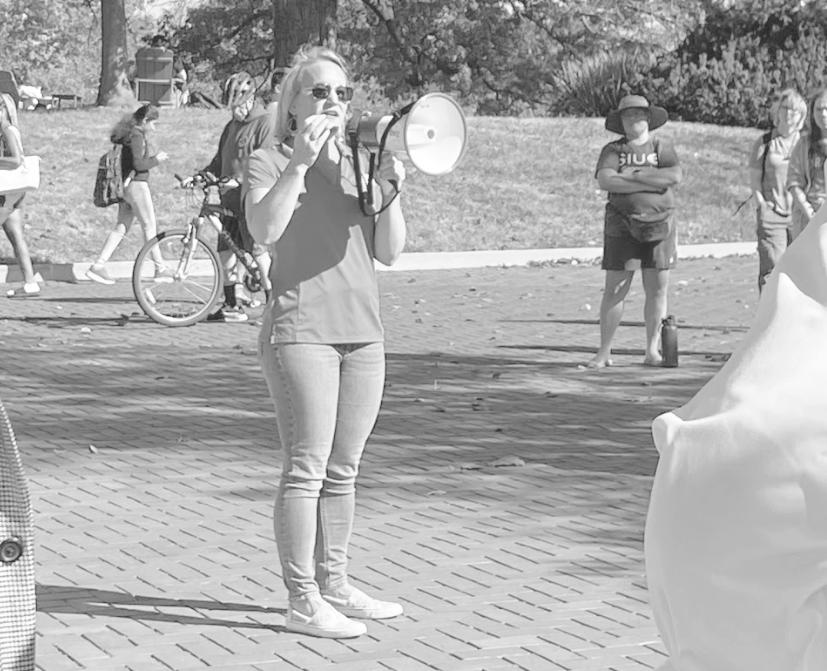
At the Nov. 7 Senate meeting it was announced that the position would be open to all senators via an email link that would be sent out by the President and Election Commission Committee.

As written in the Student Gov ernment Constitutions under Article X Section C “Senate shall, within two working weeks of the vacancy, elect a new Vice President from among its members with a two-thirds vote of approval.”
The upcoming student govern ment meeting will be on Dec. 5 fol lowing Thanksgiving break.
alestlelive.comPAGE 2 Thursday, 11.10.22
Nikki Budzinski (D-IL) is projected to win the race for Illinois’ 13th Congressional District in the U.S. House of Representative. She visited campus with other Democratic candidates last Thursday. | Nicole Boyd / The Alestle
DYLAN HEMBROUGH reporter
Lenora-Marya Anop has lived a life intertwined with music, from listening to her mother’s voice lifted in song to her own performance of Bach in Italy.
Anop, a violin instructor with SIUE’s music department, said she remembers watching her mother sing as a toddler.
“My mother was a gor geous contralto … It’s a very special voice, a very low wom an’s voice,” Anop said. “I was always going to concerts, re hearsals, lessons … I was just surrounded by music.”
Anop said she started play ing the violin at age 3 using the Suzuki method. The Suzuki method was brought to the U.S. by John Kendall, a former SIUE faculty member. The program now serves on campus to instruct children from the ages of 3 to 18 in violin technique.
“John Kendall was one of the people who was attributed with bringing the Suzuki ped agogy movement from Japan to America back in the 1960s, and the Suzuki movement is now a major international pedagogy movement for violin, for all string instruments,” Anop said. “We have students all over the world teaching Suzuki pedagogy.”
Anop said she feels her con nections to the Suzuki move ment and its progenitors in the U.S. give her a unique connec tion to this part of music history.
“I started with the Suzuki movement, and then I became the violin professor at the same university where this all came together,” Anop said. “There’s a huge history here.”
Anop performed at Carne gie Hall on the evening of Nov. 5, but it was not the first time her musical career has brought her to New York. Anop said she played in a professional quar tet for her last performance at Carnegie Hall, and she did not think that she would get that opportunity again.
“I got this invitation about a month ago, and it’s been a whirl wind. I’m so excited,” Anop said. “I’m having such a good time playing with incredible colleagues here.”
Anop also said this is not her first time performing with these particular colleagues, who she met last summer.
“I was invited to teach and perform at a music festival in Ita ly,” Anop said.
Anop said she credits the InterHarmony festival she performed at with helping to get her on track to perform
at Carnegie Hall.
“A couple years ago I had a sabbatical, and I wrote and re corded a CD … It was an enor mous research project with J. S. Bach,” Anop said. “I played some of these Bach movements in Ita ly at the concert, and everyone really seemed to enjoy them. I got this invitation because of the Bach movements that I played.”
Anop said the CD was the culmination of a lot of hard work, some of which could be frustrating at times, but ultimately rewarding.
“It was truly a labor of love,” Anop said. “Sometimes in life there are things that you just feel that you have to do, and I
had to make that CD.”
Anop said the initial rea son for making the CD was to help her improve her own teaching of violin for her stu dents, particularly in regards to solo Bach pieces.

“Bach wrote these incred ibly beautiful and ridiculously difficult works for solo violin,” Anop said. “They’re three so natas and partitas for solo vi olin. As a teacher, it’s my duty, my responsibility, to introduce my students … to the world of solo Bach.”
Anop said the solo Bach pieces she studied are some of the most difficult pieces she has encountered, describing them
as a mountain range that has to be climbed.
“I remember reading about a very famous violin pedagogue … who said that violinists re ally have no business starting with the world of solo Bach with these monumental works. He called them ‘The Himala yas,’” Anop said. “When you start understanding the world of his musical language, then go climb the Himalayas.”
Anop said her students ini tially struggled with the Bach pieces they were assigned be cause the transcriptions avail able to buy were all written for and performed by cello players, not violinists. Anop said she

had to write sheet music for vi olin before she could even begin recording the pieces.
“Making that recording … was one of the most challenging projects I’ve ever done,” Anop said. “I don’t think I’ve ever worked so hard in my life.”
Anop said the process of re cording, especially for later usage in the classroom, is a very long and self-critical journey.
“You don’t just record it once. You record it, and you re cord it, and you record it, and you go back and you study, and you say, ‘I don’t like the way that one note is too bright,’ and you find little flaws, and you go back and improve it, and you record it again,” Anop said. “This is not just a week-long project.”
Anop said she is a better teacher for her students because of the recording, not only be cause she improved her own skills, but because she is so fa miliar with the recording itself that she can point out minute details within it.
“What’s really nice is when [the students] listen to it, they can hear what I’m asking for. It’s not just speaking words through the mouth, but they can hear it,” Anop said. “There’s a different perspective, rather than just ex plaining with words.”
Anop said her connection with music runs deeper than the final performance.
“There’s so many things that are involved. It’s not just go ing out there and playing in the concert, but it’s all of the work that goes beforehand, before the concert, and that’s not always fun — it’s grueling,” Anop said. “I think very much for programs like this it’s kind of like training for a marathon. You have to pace yourself, and you have to know yourself … because some days you don’t want to practice. You’re tired, you’ve got too many other things you’ve got to do, but you have to put everything aside and be very disciplined … You have to be your own coach.”
Anop said she was told she may not be able to play violin after a bad fall several years ago, but she persisted and recovered.
“Every note, to me, is such a gift,” Anop said. “I’m not one to give up.”
Anop said music is a funda mental part of who she is, span ning her whole life from when she was going to concerts as a young girl to her performance at Carnegie Hall.
“I can’t imagine my life without music,” Anop said. “It’s in the air in my lungs. I don’t think you could take it out of me. I’ve never known life to not have it.”
alestlelive.com PAGE 3Thursday, 11.10.22
Lenora-Marya Anop has been playing music since she was 3 years old, and has been teaching it at SIUE since 1997 | Photo courtesy of Jennifer Mishra
lifestyles
SafeZone bingo night brings over $1,000 for their scholarships
BRANDON WELLS sports editor
Food, fun and performance made last Thursday’s Safe Zone drag bingo at Tropical Liqueurs in St. Louis a good time.
The event was hosted by SIUE Safe Zone, an organiza tion that helps to make members of the LGBTQ+ community feel more welcome on campus and educate people about the com munity. It is part of a regular schedule of events that the orga nization puts on to raise money for their Safe Zone scholarship, which is given out to students who participate in activism with in the LGBTQ+ community. The bingo event raised a total of $1,670 for the scholarship.
The organization worked with local drag queen Desiré Declyne to help put it on and provide guests with an oppor tunity to be introduced to the drag community.
Declyne said she felt that events like these introduce some thing to younger people that she herself didn’t get to experience until later on in life, along with the theme of bringing different people together.
Nick Niemerg, co-chair of SafeZone and president of the Queer Faculty and Staff As sociation, said bingo has been something they’ve done nu merous times with Declyne and held an event at the same venue a year before.

Niemerg said he’s grateful to get to be a part of a community
like the one that surrounds Safe Zone and how inclusive SIUE as a whole has become. As a mem ber of the LGBTQ+ community himself, he said his primary mis sion is to make sure SIUE keeps progressing as an accepting place to work.
“I really value a workplace that values me and I think SIUE does a great job at being inclu sive,” Niemerg said.
For events like these, De clyne puts on elaborate perfor mances that are planned well in advance, with outfits and makeup that she said takes up to two and a half hours to get ready.
After performing for 16 years and doing bingo events for 10 years, Declyne said she finds it easier to embrace the char acter of Desiré Declyne as the makeup goes on.
Declyne said she felt that the bingo night helped to sym bolize a place of belonging that Safe Zone provides and the lives it can save.
Mitchell Haas, another cochair of SafeZone, said he got involved with Safe Zone around two years ago and became a cochair around a year and a half ago after joining the staff at SIUE in 2019.
Haas said he himself strug gled with issues of self-accep tance throughout his early life until he came out as pansexual and nonbinary, and is involved with Safe Zone to help people feel like they have a safe environ ment on campus where they can be themselves.
“I grew up in this area, which is socially conservative, so I grew up questioning my gen der identity and questioning my sexuality,” Haas said. “My per sonal interest is to create that safe space that I felt like I never had for students and faculty and staff
on this campus.”
Haas said his time as a stu dent was never negative, but that his goal with Safe Zone is to make sure students, staff and fac ulty are all aware that they are ac cepted and to educate others on issues that the community faces.
“I was a student at SIUE 10 or 15 years ago and it’s not that it wasn’t a welcoming space, but I think that to minority groups such as the LGBTQ+ community, we can always be more welcoming and create safer spaces,” Haas said.

Local philosophers gather at SIUE to discuss and refine their work
BRUCE DARNELL reporter
Taking place over two days, the event brought in philosophers from around the country to discuss some of their work and take criticism.
Susan Dieleman, assistant pro fessor of philosophy at SIUE, was for merly the vice president of the Illinois Philosophical Association.
“In part because I was vice president, I was the local orga nizer of the conference,” Diele man said. “It often falls to the vice president to — in one of the years of their tenure — host the conference at their home in stitution, so I was responsible for organizing parts of the conference and setting up local arrangements for the meeting.”
The meeting has been hosted at other universities, such as Illinois State University in 2019. It allows for philoso
phers to gather and discuss the works of oth ers and themselves; so long as their works are accepted.
“Every year we host a confer ence where people can submit papers and [have them] reviewed,” Dieleman said. “Those that are accepted are in vited to present their work at the conference. Papers that are present ed are followed up by commenters, who comment on papers. Then there’s a question-and-answer session after.”
COVID-19 put a halt to the annual event. This meet ing was originally supposed to be held in 2020, but was rescheduled to 2021, where it was canceled and rescheduled once again.
“We finally were able to hold it this year in 2022, and it might have been good that we held it off for a couple of years,” Dieleman said. “I think people were ready to get back together and see
each other in person. We had a good sub mission rate and a good attendance rate as well. I think it was bigger than many [Illinois Philosophical Association] meet ings that were held in the past, and I think that’s partly due to people wanting to get back to doing philosophy in person again.”
While the event was not specifical ly catered towards students, it provided them a community of like-minded individ uals that they could discuss and network with and see what kind of philosophical work is being done.
“In general, a lot of the best philo sophical work happens when people have a chance to chat about their ideas, pres ent their ideas, get feedback on their ideas and answer questions,” Dieleman said. “I think it’s interesting for students in a bunch of ways as well, especially for stu dents who are thinking about doing more work in philosophy.”
Dieleman said that most states have a philosophical association. There are also no membership fees and is open to anybody who works or is interested
in philosophy.
One example of this is the meeting’s undergraduate essay contest. The author of the winning paper is invited to come speak about it, giving them a chance to get their work out in the world and have it be reviewed by professionals.
Aaron Champene, professor of phi losophy at St. Louis Community College, spoke and commentated at the event.
“The goal of the event, from the pre senter’s or author’s perspective, is trying to get feedback on your research in order to get it in shape for publication,” Champene said. “This is the first stage, basically. It’s a good and effective way to get feedback from your colleagues, some of whom you know some of whom you don’t know.”
Champene said the meeting is usually beneficial to both students and visitors.
“We have graduate students here — some of whom are presenting papers — as well as undergrad students,” Champene said. They can learn a great deal just from being around here and observing some of the research.”
contact the editor: lifestyles@alestlelive.com 650-3527 NEXT WEEK: DISCO ROLLER SKATING BROUGHT TO LIFE BY SORORITY
alestlelive.comPAGE 4 Thursday, 11.10.22
SafeZone Co-Chair Nick Niemerg (left) and Desiré Declyne come together to end the night and thank guests for attending. | Brandon Wells / The Alestle
SIUE communtiy members of all ages have tons of fun at Tons of Fun
Friday, Nov. 4th. The event was open to all SIUE community members.
Over 150 people attended the annual Tons of Fun event held
Hosted by the Campus Activities Board and Campus Rec,
the event featured several family friendly activities for children of all ages as well as adults.
Annie Crews, SIUE staff mem ber and CAB member, said as long
as a family member is affiliated with SIUE, whether that be as a student, staff member or faculty member they were invited to attend the free event.
Activities offered at the event included three different bouncy houses, an airbrush tattoo station, large yard games stationed around the gym, a caricature station.


alestlelive.com PAGE 5Thursday, 11.10.22
Sophomore Tanija Ritchie, a volunteer at the event interacts with 4-year-old Darius Wang as he and his sisters climb into one of the bouncy houses.
| Chloe Wolfe / The Alestle
CHLOE WOLFE
photographer
Freshmen Vennie Ratna Shrestha (left) and Mary Jasmine (middle) pose for a caricature.
| Chloe Wolfe / The Alestle
OPINION
EMILY STERZINGER Editor-in-Chief

 GABRIEL BRADY Managing Editor
GABRIEL BRADY Managing Editor
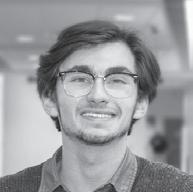
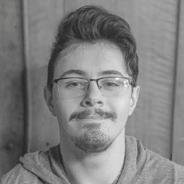

 FRANCESCA BOSTON Lifestyles Editor
BRANDON WELLS Sports Editor
FRANCESCA BOSTON Lifestyles Editor
BRANDON WELLS Sports Editor
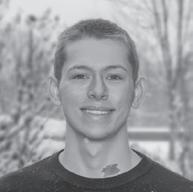 DAMIAN MORRIS Multimedia Editor
DAMIAN MORRIS Multimedia Editor
 NICOLE BOYD Online/Opinion Editor
NICOLE BOYD Online/Opinion Editor
 O’LOUGHLIN Graphics Manager
DONALD JANA HAMADE AUDREY O’RENIC Copy Editors TAMMY MERRETT Program Director
O’LOUGHLIN Graphics Manager
DONALD JANA HAMADE AUDREY O’RENIC Copy Editors TAMMY MERRETT Program Director





 UDIT NALUKALA Circulation Manager
UDIT NALUKALA Circulation Manager
HAVE A COMMENT?
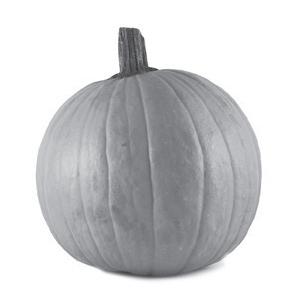
Let us know! opinion@alestlelive.com Campus Box 1167 Edwardsville, IL. 62026-1167
LETTERS TO THE EDITOR POLICY:
The editors, staff and publishers of The Alestle believe in the free exchange of ideas, concerns and opinions and will publish as many letters as possible.
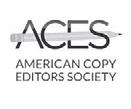


Letters may be submitted at The Alestle office: Morris University Center, Room 0311 e-mail: opinion@alestlelive.com
All hard copy letters should be typed and double-spaced. Letters should be no longer than 500 words. Include phone number, signature, class rank and major.
We reserve the right to edit letter for grammar and content. Care will be taken to ensure that the letter’s message is not lost or altered.
Letters to the editor will not be printed anonymously except under extreme circumstances. We reserve the right to reject letters.
The Alestle is published on Thursdays in print and on Tuesdays online during the fall and spring semesters. A print edition is available every other Wednesday during summer semesters.
For more information, call 618-650-3528.
For advertising, email advertising@alestlelive.com.
Share your thoughts: opinion@alestlelive.com 650-3527
Cougar Controversies

Pecan or pumpkin pie?
Questions go up at 10 a.m. every Monday on Twitter: @TheAlestle
view
This Thanksgiving, remember we’re on stolen land
with us.
It may be uncomfortable to acknowledge the true history of Thanksgiving and admit that we, as members of the SIUE community, are on stolen land – but it’s the least we can do.
SIUE exists in the lands of the Kiikaapoi, Peoria, Kaskaskia, Michigamea, Cahokia, Tamaroa and Dhegiha Siouan peoples, a fact we need to keep at the forefront of our Thanksgiving celebrations.
SIUE is hosting a land acknowledgement ceremony to acknowledge the history of our region, and that’s an important step. But the work does not stop there. As we students return home for the holidays and Thanksgiving celebrations, we need to take that knowledge
Research the history of the people who lived in our region first. Learn about the struggles Native Americans continue to face today – particularly Native American women. Native American women are two and a half times more likely to be sexually assaulted than non-Native women, and in 86 percent of those cases, the assailant is non-Native. Indigenous women are murdered at a 10 times higher rate than all other ethnicities, with murder being the third leading cause of death for indigenous women, and the majority of these murders are committed by non-Natives on Native land.
According to Native Women’s Wilderness, an organization dedicated to helping Indigenous women connect and outdoor education, “While condensing Indig-
enous Women’s experiences into a numerical value is a heavy burden that potentially relegates human women, girls and two-spirits into statistics, the current numbers illustrate the harrowing conditions for Indigenous persons within the U.S.”
So while you’re sitting down with your family to enjoy a meal that supposedly commemorates harmony between Indigenous people and colonizers, consider starting a conversation about the plight of Indigenous people today. However, don’t just focus on tragedy – Native Hope, a resource that works with tribal entities to meet various needs, asks non-Native allies to share stories of hope and Native American values, such as appreciation for community and reverence for the environment, to avoid re-
inforcing stereotypes and shift the narrative to celebrating the richness of Native tradition and modern relevance.
Consider using some of the money you would have spent on Black Friday shopping to donate to organizations committed to ending the crisis of missing and murdered Indigenous women, such as Native Hope, MMIW USA or the Coalition to Stop Violence Against Native Women.
We have a long way to go in terms of portrayals of Native Americans in the media, the celebration of Thanksgiving itself and the language we use to talk about Native Americans. A land acknowledgement ceremony is just one small step in the right direction. Let’s continue to grow as allies, however uncomfortable that may be.
Weezer is the most adaptable, endearing band of all time
Weezer’s music typically follows music trends, but they do it in a style that’s unique to them and they always accept necessary changes.
The most notable example is their debut self-titled album, known by the color of the cover as the “Blue Album”. This album has some of their most popular songs, such as “Buddy Holly,” “Undone – The Sweater Song” and “Say It Ain’t So.” “Blue” came out in 1994, just a month after Nirvana disbanded and left the grunge aesthetic as a dominating force in the music industry.
“Blue,” while inspired by much of what inspired grunge, is much more upbeat. It has light guitars and high vocals with silly lyrics. The image of the band was much cleaner, too. They didn’t smoke, drink or do drugs — not publicly, anyway. This squeaky-
clean image directly contrasted with the dark, heavy bands of the times. Despite this contrast, the “Blue Album” was a major success, reaching number 16 on the U.S. Billboard 200 list.
This image of Weezer would forever stay with them, as well as their willingness to try new things.
“Pinkerton”, their second album that was released in 1996, was a commercial failure. The harsh sound and intimate lyrics did not resonate with fans of the “Blue Album” or other commercial audiences.
Pinkerton would later become a fan favorite, despite its initial failure. However, it made them wary about abandoning the formula that garnered them success with “Blue,” which led to the creation of another self-titled album, known as the “Green Album”, which was released in 2001.
The “Green Album” received considerable commercial success. The song “Island In The Sun”
became the band’s most popular. The style of the album was much more like the “Blue Album,” with catchy guitars and upbeat lyrics. This album displayed Weezer’s ability to change and adapt, which undoubtedly saved them from total failure, as they likely would have permanently split if their next release wasn’t a success.
Weezer kept making music into the mid to late 2000s, with works such as the “Red Album” and “Make Believe.” “Raditude,” released in 2009, is one of Weezer’s least popular albums due to the total embrace of pop. The album still has its moments, usually when the band’s sound and fun lyrics are allowed to break through. The album made fans angry at the direction Weezer was taking, prompting yet another drastic return to form in 2014
“Everything Will Be Alright in the End” was Weezer’s return to form. The band used the album as a way to apologize to fans, notably in the song “Back to the Shack,” which promised a
return to their roots. The album also stated the band’s intent to make the music they wanted to make, which can be seen in the song “I’ve Had It Up To Here.” This sentiment was previously shown in the “Red Album” but was not fully realized until they created this one. The album won back many fans that made up the core audience.
The band continues to experiment with sound in their projects and takes critique from fans as they work. One fan coerced them into making a cover of Toto’s “Africa,” which led to them creating an entire cover album known as the “Teal Album.”
Weezer is one of the few bands that take their fans so seriously as to allow them to change the direction of their music. It’s almost unheard of in the industry. This, along with their distinct sound in their music, is what makes them so endearing among fans and outsiders alike.
NEXT WEEK: ABOLISH DETERMINANT SENTENCTING
THE ALESTLE STAFF editorial board
The name Alestle is an acronym derived from the names of the three campus locations of Southern Illinois University Edwardsville: Alton, East St. Louis and Edwardsville.
PAGE 6
alestlelive.com
BRUCE DARNELL reporter
KIRSTEN
ELIZABETH
ce
AMINA SEHIC
Offi
Clerk
ANGIE TROUT Offi ce Manager BRUCE DARNELL DYLAN HEMBROUGH LIV KRAUS AHMAD LATHAN Reporters WINTER RACINE CHLOE WOLFE Photographers
Thursday, 11.10.22
17% 83%







ALESTLE CLASSIFIEDS GIVE YOU MORE Place your classified ad at a convenient time for you using our easy and secure online interface: alestlelive.com/classifieds DEADLINES By noon Monday for Thursday issue or any time for Online. HAVING TROUBLE? Call (618) 650-3528 or email classifieds@alestlelive.com ALESTLE OFFICE HOURS MUC 0311 8 a.m. - 4:30 p.m. Monday - Friday alestlelive.com PAGE 7Thursday, 11.09.22 follow the alestle @alestleliveSee you on the Internet! @TheAlestle @Online Editor Alestle @thealestle
Men’s Soccer finishes OVC season, sixth place overall
JANA HAMADE copy editor
Head Coach Cale Wasser mann said that the regular season has taught them a lot of lessons and prepared them for the next stage.
The season left the SIUE Cougars at 5-8-2 with a .375 percentile, where they started the quarterfinals Missouri Valley Conference Tournament at 2-6 at a .25 percentile.

“It’s been tough. We’ve lost some tight games and didn’t finish where we wanted to in the conference,” Wassermann said. ”A couple one-goal losses to Drake, Belmond, those can go either way, and now we get a chance to make our own stamp and put our foot down in the conference tournament.”
The Cougars placed 3-4-1 in their home games and 2-5-1 in their away games, ending the OVC tournament at five wins, eight losses and two tied games in total.
The team won 2-0 against Lindenwood University, 5-1 op posing Southern Indiana, 1-0
against Western Illinois, 2-0 to University of Illinois-Chicago and 1-0 to Bradley University.

The team lost against Mis souri State University, Drake University, Belmont University, Evansville University, Saint Lou is University and Loyola Mary mount.
Graduate student midfielder Alsadiq Hasan from St. Louis, Missouri, said the team is going into the MVC tournament with a determined attitude.
“The season’s over now, and a whole new season’s starting. We didn’t fulfill our potential but now we can’t sit down and pout and cry about it, we have to look at the next game like we know that from now on we’re go ing through the playoffs,” Hasan said. “We’re number six but that doesn’t mean anything, we love going into games as the under dogs with that mentality and proving them wrong.”
The Cougars played their first MVC game of the season against Evansville at 2 p.m. on Sunday, Nov. 6 against Evans ville University’s Purple Aces, which ended with a 1-0 loss.
Cougars fall to Missouri S&T Miners in hard fought exhibition game
 FRANCESCA BOSTON lifestyles editor
FRANCESCA BOSTON lifestyles editor
For women’s basketball’s first game of the year and exhi bition game to start the season, SIUE faced an old rival, the Missouri S&T Miners, losing in the final minutes of the game by three points.
The Cougars haven’t played the Miners since 2019, when the Cougars took home a strong win, 63-47. SIUE is coming back off a season of 13 wins, an improve ment from only nine wins com
bined the two years before. Nine new players filled SIUE’s bench.
Missouri S&T started the game strong, scoring two dou bles in the first 15 seconds of the game. SIUE quickly rebounded, fighting back point for point. With 5:35 left on the clock in the first quarter, SIUE took their first timeout. The score sits at 1612 with SIUE down by four.
The Cougars continued to fight to catch up to Missouri S&T, and by the end of the first quarter, SIUE and Missouri S&T tied at 26-26.
The second quarter was a bit slower for both teams, with Missouri pulling ahead by three as SIUE took another timeout halfway through the quarter. SIUE failed to score for more than five minutes in the second quarter, falling further behind Missouri S&T. In the last minute of the second quarter, the Cou gars fought back, evening out the score. By the end of the first half, SIUE had cut the lead to five points, 43-38.
SIUE pulled the lead to a close by the middle of the third
quarter, by a point, 56-55. SIUE continued to pull ahead through out the final minutes of the third quarter, ending the quarter with a lead of seven, 59-66.
The Miner brought SIUE’s lead down in the first few minutes of the last quarter, pulling ahead.
SIUE fought back meeting the team point for point and hold ing their own throughout the last quarter. Missouri S&T pulled ahead with a free throw, with 20 seconds left. Another foul called on SIUE gave the Miners two more free throws, pulling them
ahead by 3 points.
Head Coach Samantha Smith called a timeout with 19 seconds left in the game, but SIUE was unable to gain a lead and lost by three points.
SIUE opens the season at 7:30 p.m. at St. Louis Universi ty on Nov. 11. The Cougars will play some major teams in the pre-conference season, includ ing the University of Washing ton, University of Memphis and Iowa State. Iowa State currently sits within the top 15 teams in the country.
contact the editor: sports@alestlelive.com 650-3527
alestlelive.com Thursday, 11.10.22PAGE 8
sports
NEXT WEEK: CROSS COUNTRY’S SEASONAL PERFORMANCE AND RECORDS BROKEN 4802 South State Route 159 Glen Carbon, IL 62034 3912 Maryville Road Granite City, IL 62040 509 Hamacher Waterloo, IL 62298 Our goal is to help reduce your pain and help get you back to your active life. Orthopedic and sports medicine physicians will take the time to listen to you, examine you carefully and prescribe a treatment plan that will help you get back in the game as soon as possible. When injuries sideline you, we can help you get back in the game.
Zhu, MD
Sports Medicine Schedule an appointment today. Call 618-288-4388. ilswortho.net
David
Orthopedic



















 GABRIEL BRADY Managing Editor
GABRIEL BRADY Managing Editor


 FRANCESCA BOSTON Lifestyles Editor
BRANDON WELLS Sports Editor
FRANCESCA BOSTON Lifestyles Editor
BRANDON WELLS Sports Editor
 DAMIAN MORRIS Multimedia Editor
DAMIAN MORRIS Multimedia Editor
 NICOLE BOYD Online/Opinion Editor
NICOLE BOYD Online/Opinion Editor
 O’LOUGHLIN Graphics Manager
DONALD JANA HAMADE AUDREY O’RENIC Copy Editors TAMMY MERRETT Program Director
O’LOUGHLIN Graphics Manager
DONALD JANA HAMADE AUDREY O’RENIC Copy Editors TAMMY MERRETT Program Director





 UDIT NALUKALA Circulation Manager
UDIT NALUKALA Circulation Manager














 FRANCESCA BOSTON lifestyles editor
FRANCESCA BOSTON lifestyles editor